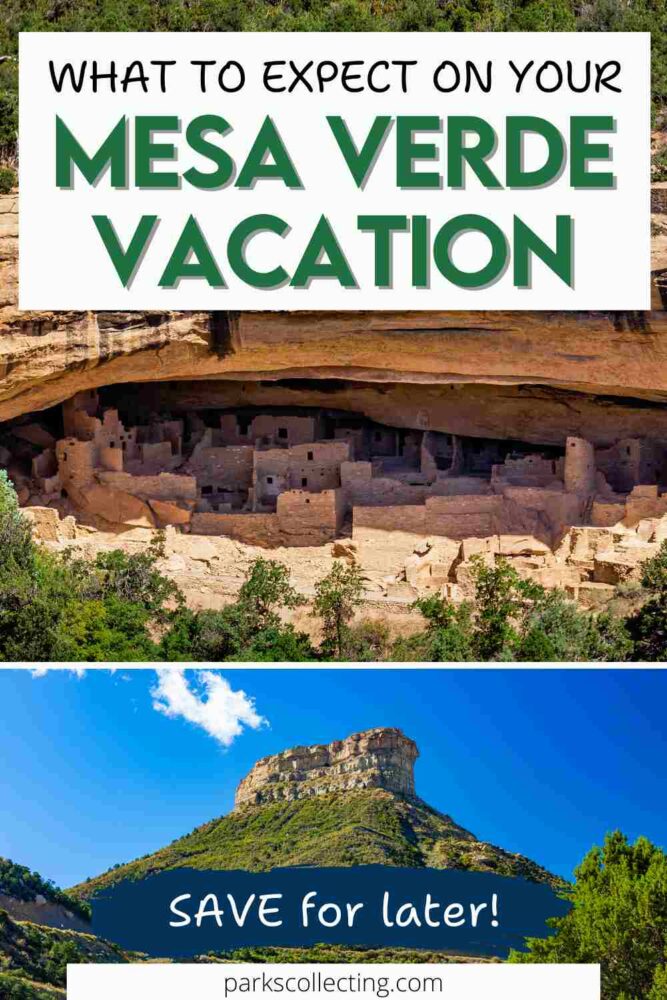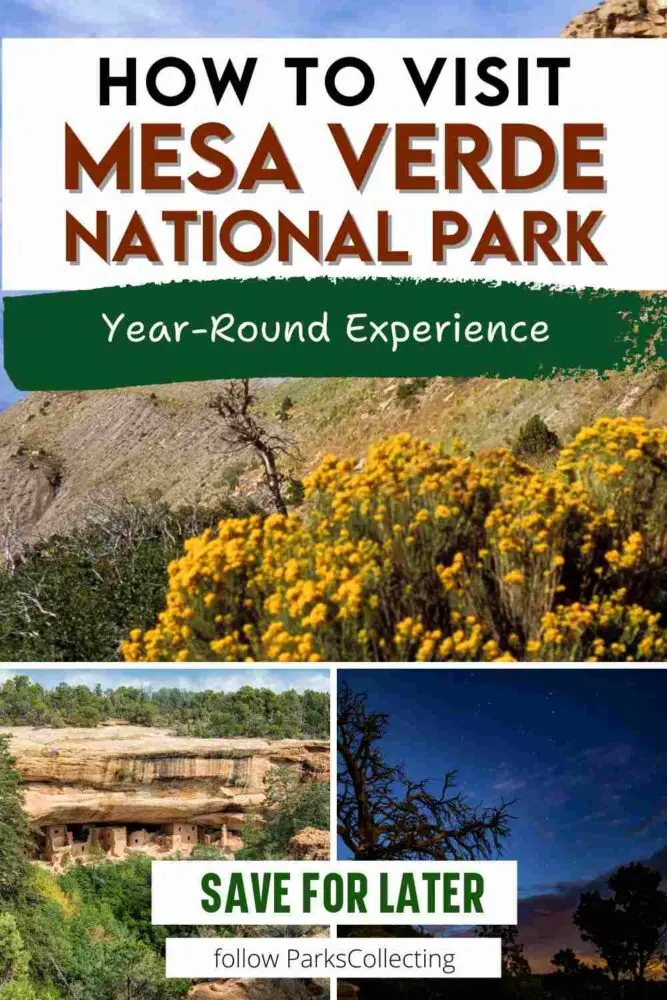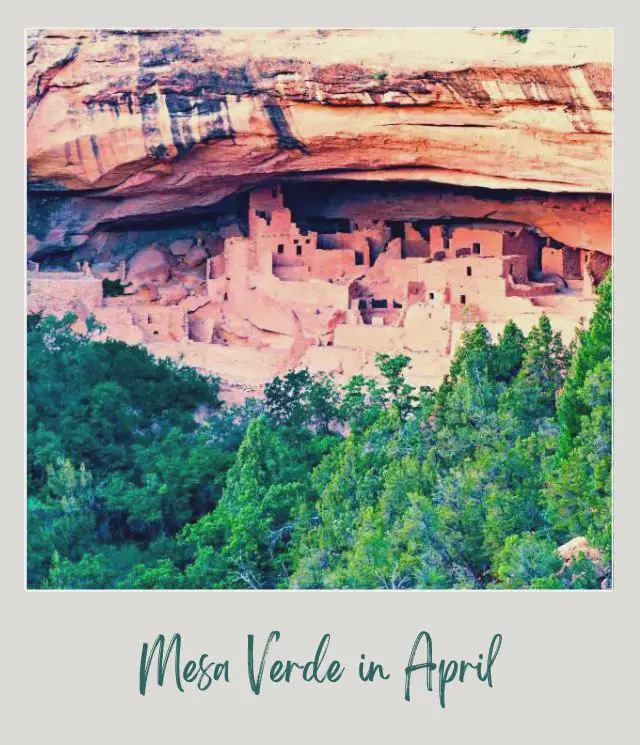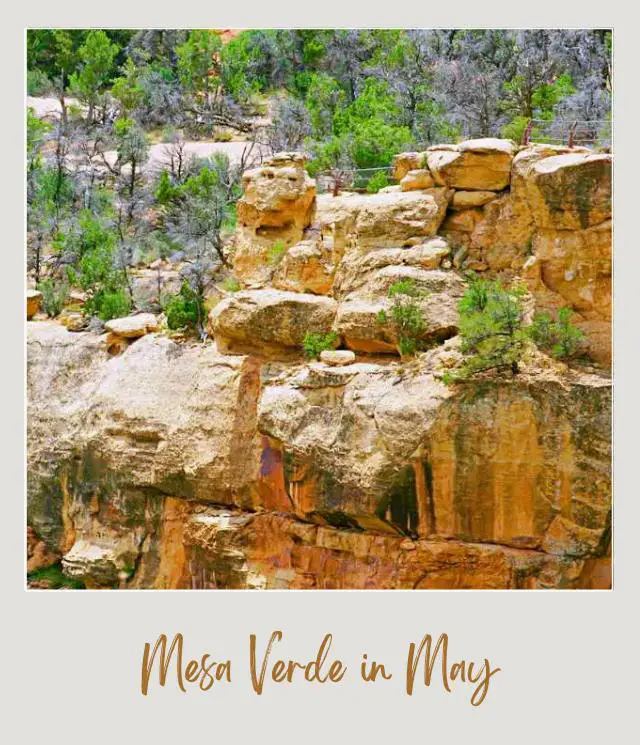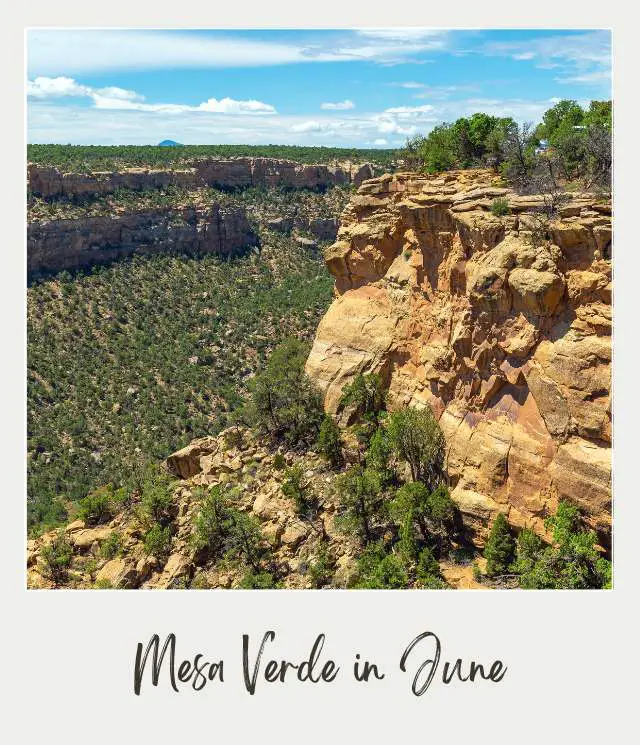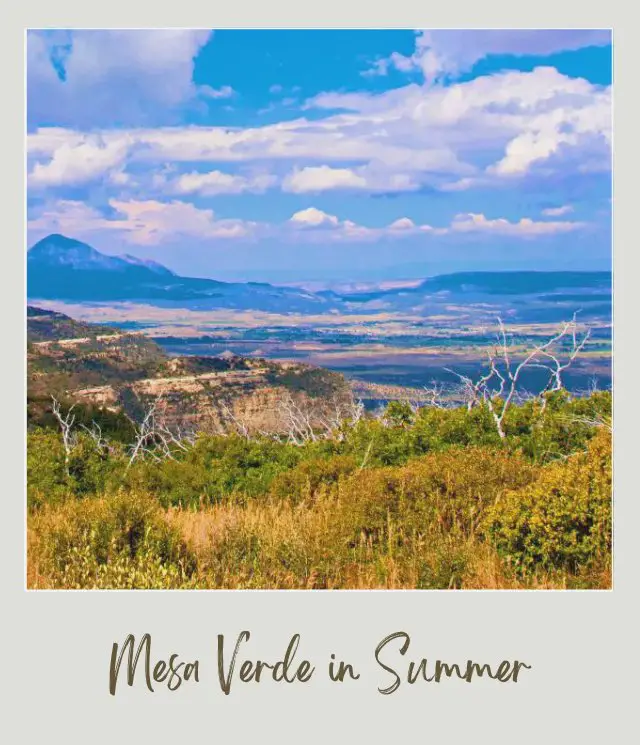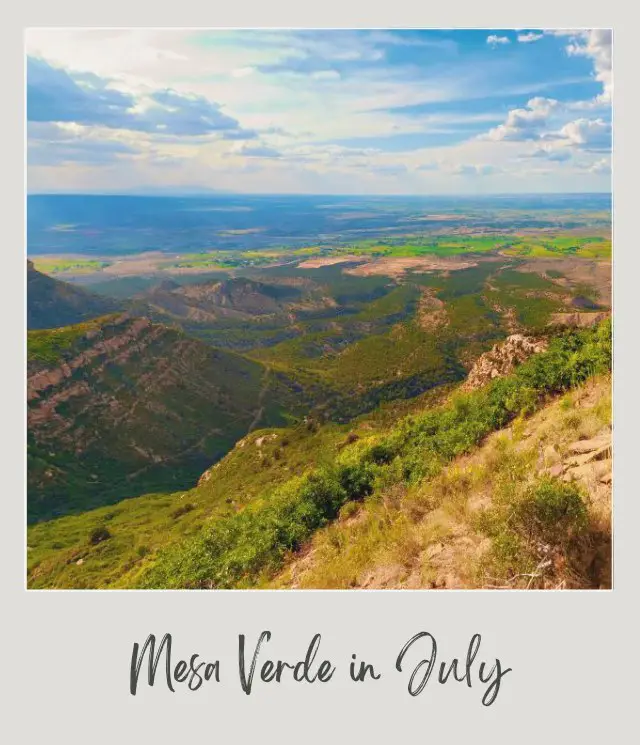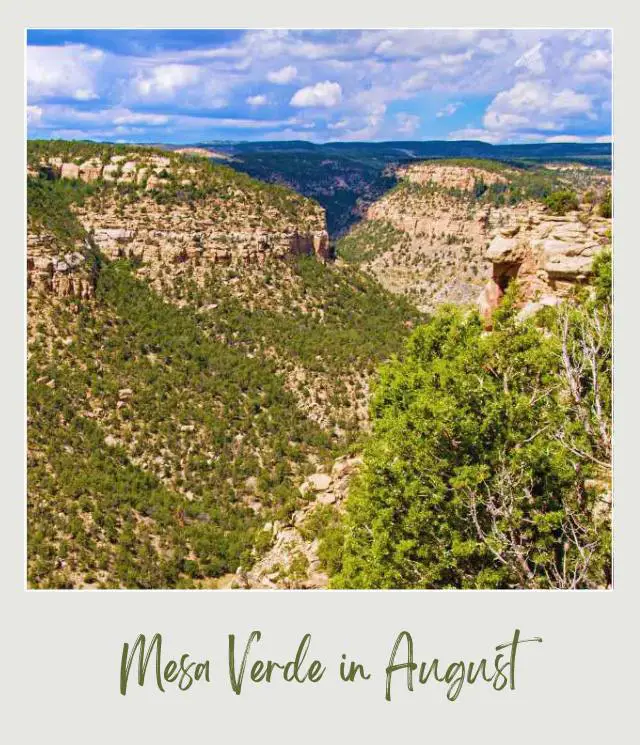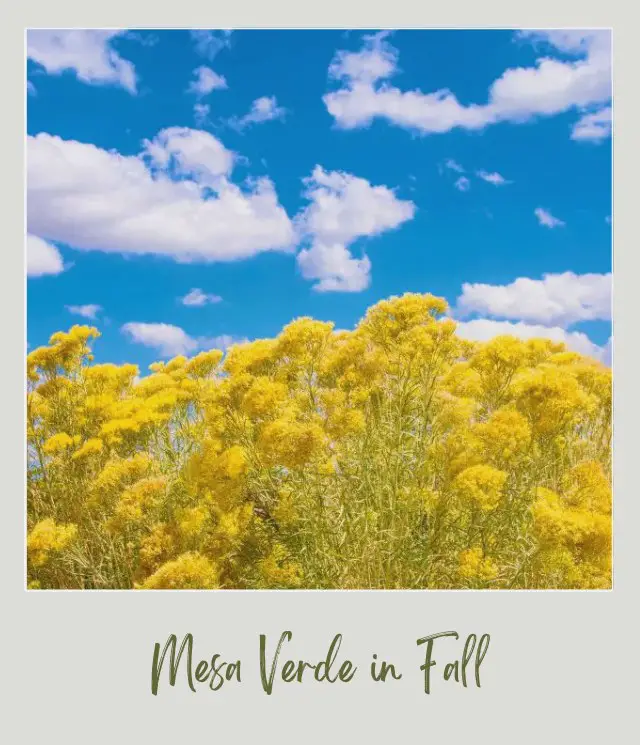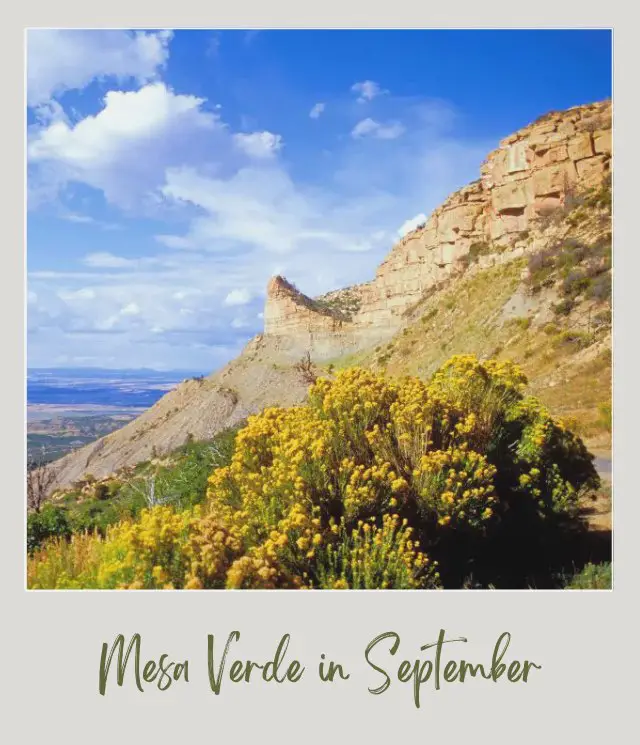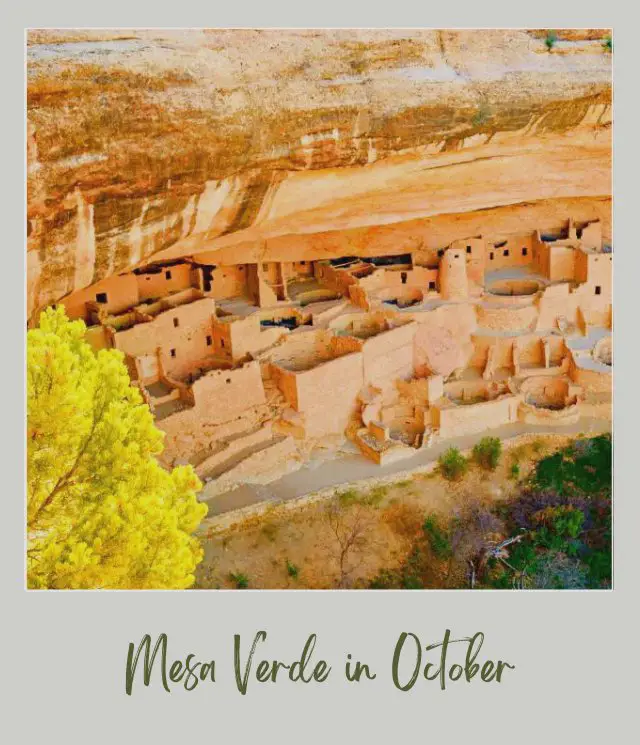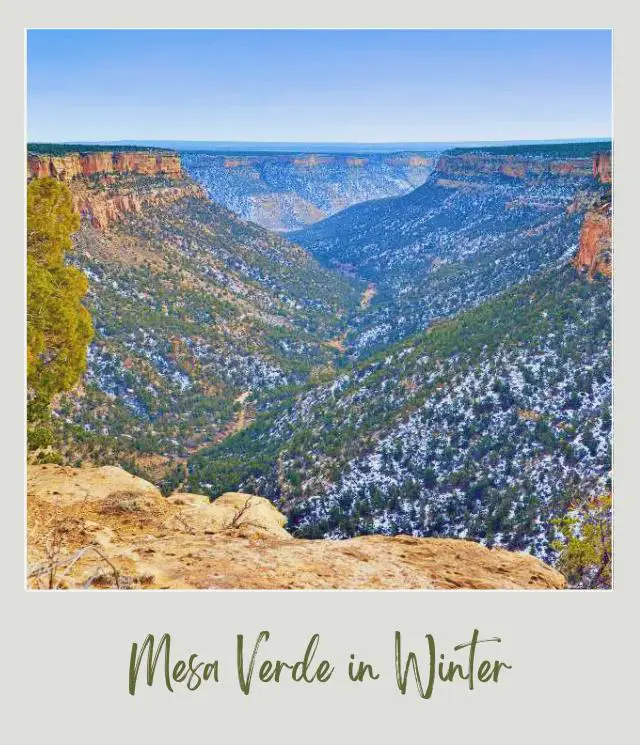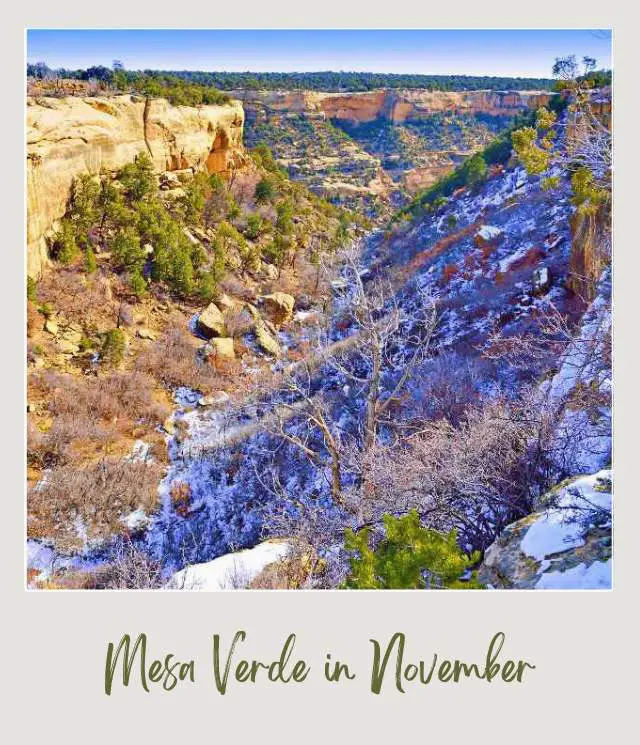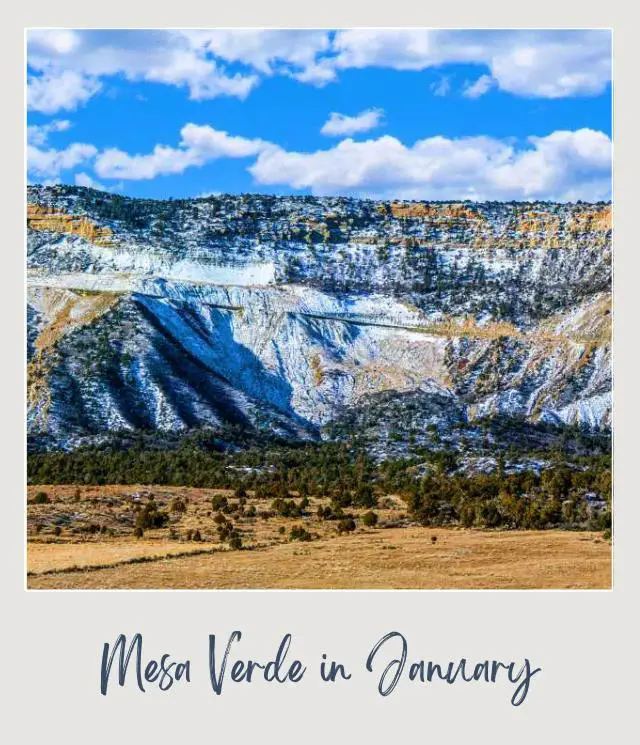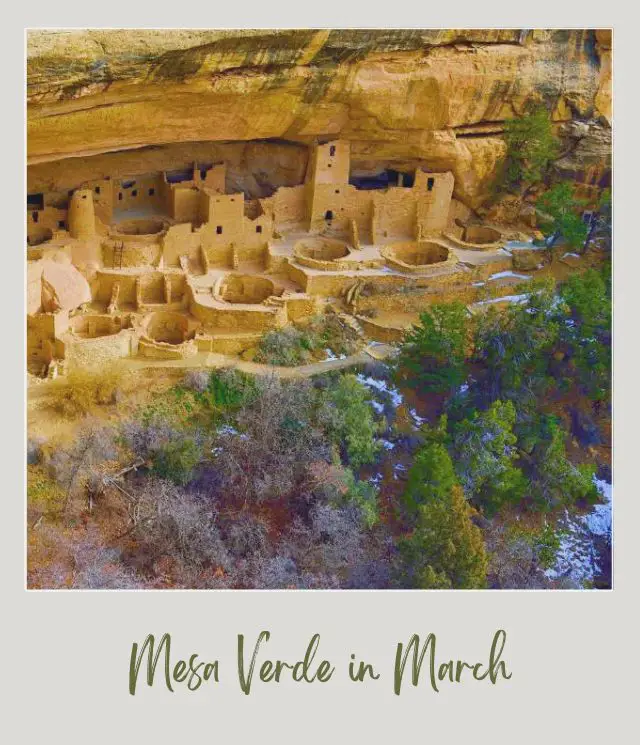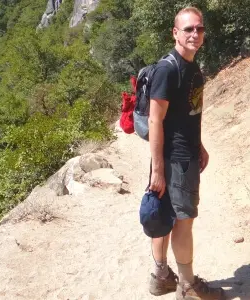Are you thinking about visiting Mesa Verde National Park but aren’t sure what to expect when you want to go? Then this guide is for you.
I’m James and I’m a national park expert. In this guide, I’ll go into detail for each month about exactly what to expect, so you can plan a trip that suits your needs.
I describe the weather in Mesa Verde National Park throughout the year, as well as typical crowds each month and what kind of activities you can do. Some activities (and most of the cliff houses) are only available at certain times of the year.
‼️ If you just want a quick snapshot about my thoughts on the best time to visit Mesa Verde National Park, check out my Best Time to Go to Mesa Verde National Park guide. ‼️
No time right now to see what Mesa Verde National Park is like throughout the year? Pin It and save it for later:
Let’s break all this down so you can figure out the best time to visit Mesa Verde National Park for you!
Mesa Verde National Park in Spring (April – June)
Springtime in Mesa Verde National Park is a refreshing time to explore.
As the park dusts off its winter frost, the park comes alive. The weather at Mesa Verde National Park starts to warm but don’t worry; it’s usually a comfortable warmth, not too hot.
And the best part? The summer crowds haven’t rolled in yet, so you might have a bit more space to yourself. So, let’s find out what spring in Mesa Verde has to offer!
Visiting Mesa Verde National Park in April
In April, you can enjoy spring’s milder weather, making it a great time to explore the park before the summer heat kicks in.
While some chill may still be in the air, temperatures are generally mild, making outdoor exploration quite comfortable. Nights in April can be cold, possibly reaching freezing temperatures.
April can still see some fluctuating weather conditions, with the potential for rain or snow, which could impact hiking or other outdoor activities. Depending on the snowmelt and recent rain, hiking trails could be muddy and more challenging.
Being off-peak, April tends to see fewer tourists, meaning you’ll have a more peaceful and less crowded experience as you explore the park.
Depending on the winter’s snowfall, some roads and trails may still be closed or have limited access, especially the higher-elevation routes. Some facilities and services might still be operating on their winter schedules or not have fully opened for the season yet. The Wetherill Mesa Road is closed and does not open until May.
April marks the commencement of ranger-led programs. The availability of these programs can be slightly limited in April compared to the summer months, but they steadily increase as spring rolls on.
While the cliff dwellings, such as Cliff Palace, Square Tower House, and Balcony House, can be seen from overlooks, they cannot be toured yet in April, and the only way you can enter all cliff dwellings to see them up close is on a ticketed tour with a ranger. The cliff dwelling tours are available between May and October.
The park’s landscape comes alive in April with blooming wildflowers like buttercups and shooting stars, adding vibrant colors to the scenery.
With the onset of spring, wildlife in the park begins to be more active, providing excellent opportunities for wildlife observation. You may spot mule deer, coyotes, and various bird species. April is also a time when many animals have their young, allowing you to observe the tenderness of wildlife motherhood.
April offers interesting stargazing opportunities at Mesa Verde, such as the Lyrid meteor shower, typically around the 22nd.
The off-peak season often comes with lower accommodation rates, making your trip more economical.
If you’re planning to stay in the park, the Morefield Campground and Far View Lodge often don’t start welcoming guests until later in the month or even early May. The exact opening dates vary depending on the weather conditions. You may have to look for accommodation in nearby towns, such as Cortez and Durango.
Pros
- Less crowded
- Wildlife spotting
- Pleasant weather
- Lower accommodation rates, in nearby towns
- Some of the ranger-led programs may be available
Cons
- Unpredictable weather
- Limited services
- Limited road and trail access
- Muddy trails
- Cliff-dwelling tours are not available
- Lodging inside the park may not be available yet
Key Events in April:
✳️ National Park Week – celebrated annually in mid-April with Earth Day celebrations, offers free admission to all national parks in the US.
✳️ Durango Bluegrass Meltdown – a festival that brings traditional bluegrass music to downtown Durango each spring.
✳️ Four Corners Home & Garden Show – an event displaying new developments in home items, interior decorating, gardening, landscaping, building ideas, and new home technologies.
Visiting Mesa Verde National Park in May
May brings pleasant weather to Mesa Verde National Park, with mild temperatures and longer daylight hours. The mornings are still cool, but the afternoons are generally comfortable for outdoor activities.
It’s a little warmer than April but comfortable enough to enjoy the park’s various activities. The nights are not as cold as in early spring or late fall, making it an ideal time for camping.
While generally mild, weather in May can be unpredictable, with cooler days, occasional rain showers, or even snow. Depending on the amount of spring rain, trails can still be muddy from the melting snow and rainfall.
May is also the beginning of pollen season. If you have allergies, particularly to tree and grass pollens, they may be triggered during your visit.
Most of the park’s roads and trails are open and accessible in May. Those at higher elevations may still have patches of snow and be subject to temporary closures, but there are fewer chances of closures compared to April.
While May is not peak tourist season, it’s the start of the visitor season, and there might be an influx of visitors at the popular sites, especially around the Memorial Day holiday. It could lead to crowded trails and longer wait times for tours.
Most of the park’s services and facilities are usually open in May. There’s also a rise in the number of ranger-led programs.
The cliff-dwelling tours also begin in May. You can enjoy it with less interruption as the summer crowds have yet to arrive.
May is a great time to witness the park’s wildlife, with opportunities to spot mule deer, rabbits, and various bird species. Many baby animals born in April are now more active and visible, adding excitement to wildlife spotting.
The vegetation is lush and green, and the park bursts with vibrant wildflowers, such as lupines and Indian paintbrush, creating a picturesque backdrop.
The night sky remains an enchanting spectacle in May. The Eta Aquariid meteor shower is the highlight of this month, usually peaking in early May. As temperatures at night are a bit warmer than in April, spending time under the stars becomes more comfortable.
The accommodation costs in May are likely to be higher than in April or October but potentially less than the height of the summer months (June, July, August) when demand is at its peak.
Both Morefield Campground and the Far View Lodge are typically open by May.
Pros
- Mild weather
- Increased wildlife activity
- Less crowded than in the summer
- More access to trails
- Most of the park’s facilities are open
- Increased ranger-led programs
- Cliff dwelling tours are available
- Lodging inside the park is available
- Vibrant scenery
Cons
- Unpredictable weather
- Limited road and trail access in case of bad weather
- Beginning of the visitor season
- Beginning of the pollen season
- Muddy trails
Key Events in May:
✳️ Mesa Verde Country Indian Arts and Culture Festival – a festival that celebrates the rich Native American culture and arts of the region and features traditional dance performances, art exhibits, storytelling, and workshops.
✳️ Ute Mountain Mesa Verde Birding Festival – an unforgettable birding experience in the Four Corners region, where cultural landscapes meet diverse habitats. Explore high desert to mountain terrain, enjoy guided tours by local experts, attend insightful lectures, savor a banquet with a keynote speaker, and participate in a silent auction. Discover the beauty of birdwatching on personalized tours amidst stunning surroundings.
✳️ Animas River Days (Durango) – an exciting celebration encompassing a variety of activities, such as river surfing, stand-up paddling, freestyle kayaking, raft and kayak slalom, boater cross, the inflatable rodeo, and a festive river parade adorned with costumes.
✳️ 12 Hours of Mesa Verde – a mountain bike race engaging relay teams and solo participants, challenging them to complete the highest number of laps between 7 AM and 7 PM. The event takes place at the Montezuma County Fairgrounds, and the remarkable 16-mile single track course utilizes trails located within the well-known Phil’s World trail system.
Visiting Mesa Verde National Park in June
June marks the beginning of summer in Mesa Verde National Park, and the weather begins to warm up considerably. The days are longer, allowing for more time to explore the park.
However, the higher summer temperatures might be uncomfortable for some visitors, especially during hikes or other strenuous activities. There may be an increased risk of wildfires in the area during this time of year that can potentially impact air quality and visibility.
June is one of the busiest months at Mesa Verde National Park due to the summer season. Be prepared for larger crowds, especially at popular sites and peak visiting hours. If you want to visit in June, it’s best to choose the first two weeks of the month as they are usually slightly less busy than the rest.
Most of the park’s trails are open and accessible and you can enjoy full access to park facilities and services.
The ranger-led programs are in full force in June, offering numerous opportunities to learn more about the park’s history, geology, and ecosystem.
The cliff dwelling tours are also available in June, and with summer’s arrival, you get extended hours to explore these remarkable structures.
By June, the park is alive with the hustle and bustle of wildlife. From the chattering of birds to the sightings of mule deer and coyotes, the park is a haven for nature lovers. Young animals, born in the spring, are growing and exploring, adding a playful dimension to the wildlife scene.
The plant life is also at its peak, painting the park with various shades of green and filling the air with the scent of blossoming flowers.
June is an ideal time to witness the mesmerizing phenomenon of lenticular clouds at Mesa Verde. These unique, lens-shaped clouds often form over the park’s high mesas, creating a surreal and captivating sight for photographers and nature enthusiasts.
In June, the Milky Way becomes more prominent in the night sky at Mesa Verde. You may be able to observe the Bootids meteor shower in late June.
With increased visitors, securing accommodation might require advanced booking, and prices might be higher. The Morefield Campground and the Far View Lodge are usually fully operational in June.
Pros
- Warmer weather
- Long days
- High wildlife activity
- Flora is in full bloom
- Full access to park facilities and services
- Ranger-led programs in full force
- Cliff dwelling tours are available
- Lodging inside the park is available
Cons
- Crowds
- Higher temperatures
- Lower accommodation availability and higher prices
- Possible wildfire risk
Key Events in June:
✳️ Animas River Days (Durango) – an exciting celebration that encompasses a variety of activities such as river surfing, stand-up paddling, freestyle kayaking, raft and kayak slalom, boater cross, the inflatable rodeo, and a festive river parade adorned with costumes.
✳️ Mesa Verde Country Indian Arts and Culture Festival – celebrates the rich Native American culture and arts of the region and features traditional dance performances, art exhibits, storytelling, and workshops.
✳️ Dolores River Festival – an incredible celebration that beckons nature enthusiasts and music lovers alike to come together along the majestic banks of the Dolores River, where harmonious melodies blend with the rhythm of cascading waters, creating an enchanting ambiance that immerses attendees in a joyful, outdoor extravaganza filled with live music, vibrant art, and a deep appreciation for the wonders of nature.
✳️ Telluride Bluegrass Festival – an enchanting celebration where nature’s melodies dance with the soulful twang of bluegrass, creating a harmonious gathering that captivates hearts and awakens spirits.
Mesa Verde National Park in Summer (July – August)
Moving on to summer! When it comes to weather Mesa Verde National Park, CO, likes it hot! It’s prime time for the park, so expect more visitors.
But hey, the buzz can be part of the fun! With long, sunny days, it’s a great time to soak up the park’s beauty. But remember, it can get pretty warm, so be sure to pack your sunscreen and hat. Ready to see what summer at Mesa Verde is like? Let’s take a look.
Visiting Mesa Verde National Park in July
July is squarely in the middle of summer, meaning it’s typically warm and sunny, offering great weather conditions for exploring the outdoors. July has some of the longest days of the year, maximizing daylight for exploring the park.
It can, however, get quite hot, especially in the afternoons, which may be uncomfortable for some visitors, especially during strenuous activities like hiking. The lack of tree coverage at overlooks may make it feel even hotter.
Late July marks the beginning of the monsoon season, which can result in afternoon thunderstorms and flash floods.
July also falls within wildfire season. Wildfires can affect air quality, visibility, and access to certain parts of the park.
As it’s peak tourist season, you can expect the park to bustle with visitors in July. It creates a lively atmosphere but also means popular sites can get crowded. It’s always a good idea to start your day early to avoid the largest crowds and the hottest part of the day.
Most of the trails are open and accessible and all park services and facilities are fully operational.
July is a busy month for ranger-led programs, with various options for visitors.
The Ancestral Puebloan cliff dwellings can be experienced fully during the long summer days. Even though visitor numbers are higher, the extended daylight hours provide ample opportunities for exploration.
July is a prime time for wildlife spotting at Mesa Verde. Young animals born earlier in the year are more visible, exploring their surroundings under the watchful eyes of their parents. The park’s diverse bird population is also lively, making July a delightful month for birdwatching. Keep an eye out for mule deer, rabbits, and various bird species as you traverse the park.
The diverse plant life also flourishes, with colorful wildflowers dotting the landscape during this time.
Stargazing remains a standout activity in July. Warmer nights make it comfortable to stay out later, and the park’s minimal light pollution provides fantastic views of the Milky Way. You might be lucky to catch the Delta Aquarids meteor shower that peaks at the end of the month.
With the park being busy, accommodation can fill up quickly, so booking well in advance is advisable. Both Morefield Campground and the Far View Lodge are open and often bustling with visitors in July.
Both inside and outside the park, accommodation rates are likely to be at their highest during this peak tourist period.
Pros
- Great weather
- Long days
- High wildlife activity
- Vibrant flora
- Full range of services
- Numerous ranger-led programs
- Cliff dwelling tours are available
- Lodging inside the park is available
Cons
- Crowds
- Hot temperatures
- Monsoon season: possible afternoon thunderstorms and flash floods
- High accommodation demand and costs
Key Events in July:
✳️ Durango Fiesta Days – a week-long celebration including rodeos, parades, live music, art shows, and various family-friendly activities.
✳️ Four Corners Gem and Mineral Show – an event that brings together vendors and enthusiasts of gems, minerals, fossils, and jewelry.
✳️ Music in the Mountains Festival (Durango) – an annual festival that takes place throughout July in Durango and features classical music performances by renowned musicians and orchestras from around the world.
Visiting Mesa Verde National Park in August
August is typically warm, providing great weather conditions for outdoor exploration. It can still be quite hot, especially in the afternoon, so it could make hiking more challenging.
August is in the middle of the monsoon season, which can bring afternoon thunderstorms and flash floods. Hiking trails can be muddy or even temporarily closed. There can also be a risk of wildfires, which can impact air quality, visibility, and even access to parts of the park.
August, like July, is part of the peak tourist season. Therefore, expect the park to be busy. Early mornings and later afternoons tend to be less crowded, making these good times for visiting popular sites.
If you want to visit Mesa Verde National Park in August, it’s best to go in the last two weeks of the month, which tend to be slightly less busy.
The park’s roads and trails are open and accessible during August, providing excellent opportunities for exploration. All park facilities and services are in full operation.
August continues to offer a wide range of ranger-led programs. Cliff dwelling tours are also available in August.
In terms of wildlife, August continues to be an active month. Many young animals born in spring are now becoming more independent, which can lead to some interesting wildlife observations. As you venture through the park, keep your eyes peeled for mule deer, rabbits, and various bird species.
The bird life in the park is also vibrant, offering plenty of opportunities for bird watching.
The diverse plant life is also in full bloom, with vibrant wildflowers adding pops of color to the landscape.
August is the peak season for the blooming of yucca plants at Mesa Verde National Park. Keep an eye out for their tall stalks adorned with creamy white flowers, providing a stunning contrast against the desert landscape.
August brings one of the year’s most anticipated astronomical events, the Perseid meteor shower. It typically peaks in mid-August and is often considered one of the year’s best meteor showers due to its high frequency of meteors.
With the park being quite popular in August, accommodations can fill up quickly, and it’s advisable to book well in advance. Both the Morefield Campground and the Far View Lodge are open in August.
Accommodation and other travel costs may be at their peak due to the high demand during this time.
Pros
- Warm weather
- Active wildlife
- Summer flora
- Full access to park services and facilities
- Variety of ranger-led programs
- Cliff dwelling tours are available
- Lodging inside the park is available
Cons
- Crowds
- High temperatures
- Monsoon season
- Wildfire risk
- Hight accommodation costs and demand
Key Events in August:
✳️ Cortez Rendezvous Hot Air Balloon Rally – an exhilarating gathering that paints the sky with vibrant colors and a sense of wonder as magnificent hot air balloons take flight in a spectacular display of grace and adventure.
✳️ Mesa Verde Country Food, Wine, and Art Festival – brings together the delectable flavors of local cuisine, the exquisite charm of regional wines, and the captivating beauty of artistry, creating an unforgettable experience for all who attend.
✳️ Durango Blues Train – an incredible experience of live blues music aboard a remarkable piece of history, the Durango & Silverton Narrow Gauge train. Set against the backdrop of Colorado’s breathtaking canyons, this unique attraction combines the soulful tunes of blues with the nostalgic ambiance of a coal-fired, steam-powered locomotive.
✳️ San Juan Brewfest – considered one of the best beer-tasting festivals in the Four Corners and brings together beer enthusiasts and local brewers in a lively celebration where the air is filled with the delightful aromas of craft beer and the joyful clinking of glasses.
Mesa Verde National Park in Fall (September – October)
As the summer heat in Mesa Verde National Park starts to chill out, fall brings its own awesome vibe to the park. The temperatures cool down, the leaves start changing colors, and the park gets quieter as the summer crowds thin out.
It’s a fantastic time to enjoy all the park has to offer without the hustle and bustle. Let’s see what fall at Mesa Verde is all about!
Visiting Mesa Verde National Park in September
September brings more pleasant weather to Mesa Verde National Park, with cooler temperatures than summer. Mornings and evenings may have a slight chill. During the day, the weather remains comfortable for outdoor activities.
September sees the transition from summer to fall, and with that comes a temperature drop, making outdoor exploration more comfortable compared to the hotter summer months.
There could still be a risk of wildfires in September impacting the park. The tail end of the monsoon season can extend into early September, potentially causing afternoon thunderstorms and muddy conditions on hiking trails.
Days start to get shorter in September, which means less daylight for exploring the park.
While the park is still popular in early September, visitor numbers decrease as the month progresses. Some visitor services and facilities may have reduced hours or be closed for the season.
The majority of the park’s trails and roads are still open and accessible in September.
Most facilities and services are typically still available. Depending on the year and weather conditions, some facilities or attractions may start to close towards the end of September.
Ranger-led programs continue in September, although the frequency of these programs may start to decrease as the season winds down. Cliff dwelling tours are still available in September.
September is a fascinating time for wildlife viewing. As the season changes, many animals prepare for winter, foraging to stock up for the colder months. This flurry of activity can be captivating for wildlife enthusiasts. Keep an eye out for mule deer, rabbits, and various bird species as you traverse the park’s trails.
September brings the opportunity to witness the impressive migratory bird movement known as the “fallout” at Mesa Verde. It occurs when many birds rest and refuel within the park before continuing their journey southward. It’s a unique spectacle for birdwatchers.
While the peak wildflower season has passed, September still offers a picturesque landscape with hints of autumn colors. You can appreciate the beauty of the park’s diverse flora, including golden grasses and scattered wildflowers.
September offers the chance to witness the transition from summer to fall constellations at Mesa Verde. Look for the Great Square of Pegasus and the Andromeda Galaxy, both visible in the autumn sky. With clear, cool nights, the park provides an excellent opportunity to marvel at the Milky Way and the occasional meteor shower.
You can expect accommodation costs to be lower in September than in the peak summer months (June, July, August).
The Morefield Campground and the Far View Lodge are typically open in September. As the month progresses and visitor numbers decrease, securing a reservation may be easier than during the peak summer months.
Pros
- Milder weather
- Active wildlife
- Changing foliage
- Less crowded
- Ranger-led programs
- Access to most of the park’s services and facilities
- Cliff dwelling tours are available
- Lodging inside the park is available
Cons
- Variable weather
- Shorter days
- Reduced opening hours
- Monsoon season
- Wildfire risk
- Lowe accommodation cost and demand
Key Events in September:
✳️ Durango Cowboy Poetry Gathering – a celebration where the essence of the Wild West comes alive through heartfelt words, enchanting melodies, and captivating tales as passionate cowboys and cowgirls gather to share their stories and pay homage to the timeless traditions of the American frontier.
✳️ Four Corners Motorcycle Rally (Durango) – one of the best riding rallies in the United States, with a weekend full of bikes, live music, motorcycle giveaways, stunt shows, racing, bike shows, great food, drinks, and more!
Visiting Mesa Verde National Park in October
October brings cooler temperatures and beautiful fall colors to Mesa Verde National Park. Mornings and evenings tend to be chilly. Temperatures drop significantly in October, especially at night. If you’re camping, be prepared for potentially cold conditions.
During the day, the weather is generally pleasant for outdoor activities. Daylight hours are decreasing, giving you less time for exploring.
The weather in October ranges from warm early fall temperatures to cooler conditions as the month progresses.
Occasional early snowfall can occur, so it’s wise to watch the weather and pack accordingly. An early onset of winter with snowfall could affect road conditions and accessibility to certain parts of the park.
October generally sees fewer visitors than the summer months, allowing for a more peaceful experience.
However, certain visitor services and facilities may have limited hours or begin to close for the winter season, particularly toward the end of the month. Mid-October is a good time to explore the park as there are fewer visitors, while most park sites and activities are still open.
Ranger-led programs may begin to taper off in October, but there are usually still several options to choose from, particularly in early to mid-October.
Cliff dwelling tours end towards the end of October, so it’s the last month of the year when you can join one.
Most of the park’s trails and roads remain open and accessible in October. However, there might be an early onset of winter with snowfall that could affect road conditions and accessibility to certain parts of the park. The Wetherill Mesa Road closes at the end of October (or earlier) and doesn’t open again until May.
The changing of the seasons also impacts the park’s wildlife. Migratory birds are well on their way south, while other animals can be spotted preparing for the coming winter. Keep your eyes peeled for mule deer, rabbits, and various bird species as they navigate the changing season.
While fall is an active period for many animals, some may have begun to hibernate, potentially limiting viewing opportunities for wildlife.
October is a great time to catch the fall colors in the park as the foliage shifts from vibrant greens to fiery reds and oranges.
Stargazing in October can be a special treat. The clear, cool nights provide an excellent backdrop for viewing the stars, with less chance of summer thunderstorms. The Orionid meteor shower typically peaks in October, adding a thrilling spectacle to your stargazing experience.
With the decrease in demand, the cost of accommodations in and around the park will likely be lower than in the peak season.
Both the Morefield Campground and the Far View Lodge generally remain open in early October, though the campground usually closes for the season around mid-October. The lodge often stays open until the end of the month.
Pros
- Autumn scenery
- Comfortable temperatures
- Less crowded
- Lodging inside the park is available
- Cliff dwelling tours are available (until the middle of the month)
- Lower accommodation costs and demand
Cons
- Variable weather
- Colder nights
- Shorter days
- Variable wildlife activity
- Limited services
- Early winter
Key Events in October:
✳️ Mancos Cowboy Half Marathon, 5K & Fun Run – a series of trail running events on a mix of pavement, dirt road, and trail, offering spectacular views of the Mancos Valley and Mesa Verde.
✳️ Oktoberfest Durango – a family-friendly event where you can sip beer and enjoy live entertainment from local musicians as well as delicious food, games, and more.
Mesa Verde National Park in Winter (November – March)
Mesa Verde National Park winter trip is a whole different ball game in these months. The park gets a beautiful, snowy makeover, and the crowds are at their thinnest. The temperatures can get quite chilly, so pack your warm gear.
Let’s see what winter in Mesa Verde looks like!
Visiting Mesa Verde National Park in November
November marks the transition into the colder season at Mesa Verde National Park. Be prepared for cool and crisp temperatures throughout the day, with chilly mornings and evenings.
The weather during this month typically sees more cold days, with the possibility of early winter snowfall.
The park quiets down significantly in November, with fewer visitors than during the peak months, providing a more peaceful atmosphere.
In November, some of the trails and the park’s main road (the Cliff Palace Loop) might be closed for the winter season. The Wetherill Mesa Road is closed and does not open until May.
Visitor services and facilities may have reduced hours or be closed in November.
Ranger-led programs are usually less frequent in November due to the off-peak season. The cliff dwellings can no longer be toured in November.
Wildlife at the park prepares for winter in November. Some animals can be observed foraging for the last of the fall bounty before the harsh winter sets in. Most of the migratory birds have completed their journey south. Many animals may have begun winter hibernation, so wildlife viewing could be limited.
The vibrant fall foliage starts to fade, giving way to bare trees and earthy tones.
November brings an opportunity to witness the Taurid meteor shower, which typically occurs throughout the month. You might also be able to catch the Leonid meteor shower, which peaks in mid-November.
As this is an off-peak season, accommodation prices are typically lower inside and outside the park.
The Morefield Campground is typically closed in November, but the Far View Lodge often remains open until early in the month. Accommodation options outside the park are available throughout the year.
Pros
- Fewer crowds
- Late Autumn scenery
- Cooler weather
- Lower accommodation costs and demand
Cons
- Unpredictable weather
- Shorter days
- Limited services
- Limited road and trail access
- Reduced daylight hours
- Cliff-dwelling tours are not available
- Lodging inside the park may not be available
- Limited wildlife viewing
Key Events in November:
✳️ Durango & Silverton Narrow Gauge Railroad Polar Express – an enchanting holiday experience where families embark on a magical journey aboard a vintage steam train, immersing themselves in a whimsical world of sparkling lights, cheerful carols, and the heartwarming spirit of Christmas.
Visiting Mesa Verde National Park in December
December brings the onset of winter. The temperature in Mesa Verde National Park is low and there is a higher likelihood of snowfall. Rapidly changing conditions might limit outdoor activities. With shorter daylight hours, you’ll also have less time for outdoor activities during the day.
If you enjoy winter landscapes, December can offer snow-covered vistas, transforming the park into a winter wonderland. It’s a great opportunity for photography enthusiasts to capture stunning shots of the park’s snow-covered vistas.
Outdoor activities during winter in Mesa Verde are limited due to the weather conditions. However, depending on the snowpack, cross-country skiing, and snowshoeing may be possible.
December sees fewer visitors at Mesa Verde National Park, offering a serene and peaceful atmosphere.
Winter weather can impact access to certain areas of the park. Some roads and trails may be closed or have limited access due to snow or icy conditions. The Wetherill Mesa Road is closed and does not open until May.
Visitor facilities and services may have reduced hours or be closed for the season.
Many of the park’s services, including ranger-led tours, are unavailable during winter. The cliff dwellings cannot be toured In December.
Winter’s arrival brings a shift in the park’s wildlife. Many animals are less active or in hibernation, but you can still spot some species, such as mule deer, rabbits, and winter birds. Watch for animal tracks in the snow, a fun way to learn about the park’s wildlife.
December offers the chance to observe the Geminid meteor shower, one of the most reliable and active meteor showers of the year, typically peaking in mid-December.
The Far View Lodge and Morefield Campground are typically closed in December. However, there are several accommodation options in nearby towns that are open year-round. Accommodation prices in nearby towns are typically lower during this off-peak season.
Pros
- Peaceful experience
- Winter scenery
- Lower accommodation costs in nearby towns
Cons
- Cold weather
- Limited road and trail access
- Limited services
- Reduced daylight hours
- No ranger-led programs
- Cliff-dwelling tours are not available
- Lodging inside the park is not available
- Limited wildlife viewing
Key Events in December:
✳️ Durango & Silverton Narrow Gauge Railroad Polar Express – an enchanting holiday experience where families embark on a magical journey aboard a vintage steam train, immersing themselves in a whimsical world of sparkling lights, cheerful carols, and the heartwarming spirit of Christmas.
✳️ Mesa Verde Luminaria Evening – a truly enchanting event where the ancient spirits of the Mesa Verde National Park come alive amidst the gentle glow of countless luminarias, creating a mesmerizing atmosphere that transports visitors to a bygone era of mystical wonder and captivating beauty.
✳️ Festival of Trees (Durango) – a celebration where the town comes alive with the vibrant spirit of the holiday season, as ornately decorated trees transform into mesmerizing works of art, spreading joy and wonder to all who visit.
Visiting Mesa Verde National Park in January
January sees cold temperatures with the potential for snowfall. The park’s weather can change quickly.
Outdoor activities during January are limited due to the harsh Mesa Verde winter conditions. With less daylight, you’ll also have less time for outdoor activities.
January provides the opportunity to experience the quiet beauty of frozen waterfalls within Mesa Verde National Park. As temperatures drop, waterfalls along the canyon walls may transform into magnificent ice formations, creating stunning winter scenery.
Being off-peak, January offers a peaceful visit, with fewer visitors in the park than in other seasons.
January is an excellent time to witness snow-blanketed cliffs and ruins if you enjoy winter landscapes.
Winter weather significantly impacts access to the park. Due to snow and icy conditions, many roads and trails are closed or have limited access. The park’s facilities and services may have reduced hours or be closed for the season. The Wetherill Mesa Road is closed and does not open until May.
Ranger-led programs are not available in January due to the season and the cliff dwellings cannot be toured in January.
The park’s wildlife in January is in full winter mode. Many animals, like bears, are hibernating, while others, such as mule deer and rabbits, are still active. Keep an eye out for their tracks in the snow, a unique, surprisingly engaging winter activity.
Stargazing opportunities are exceptional in January, given the long winter nights. The Quadrantid meteor shower, which typically peaks in early January, can be a particularly exciting spectacle for astronomy enthusiasts.
The Far View Lodge and Morefield Campground are usually closed in January, but several year-round lodging options can be found in nearby towns.
Accommodation prices in nearby towns are typically lower during this off-peak season.
Pros
- Peaceful experience
- Winter scenery
- Lower accommodation costs in nearby towns
Cons
- Cold weather
- Limited services
- No ranger-led programs
- Limited road and trail access
- Limited wildlife activity
- Short daylight hours
- Cliff-dwelling tours are not available
- Lodging inside the park may not be available
Key Events in January:
✳️ Snowdown Festival – a winter festival held in Durango in late January or early February. It features parades, costume contests, live music, and snowboarding competitions.
Visiting Mesa Verde National Park in February
February is a winter month with cooler temperatures and the potential for snowfall.
Visiting Mesa Verde National Park in February offers an off-the-beaten-path experience with snowy landscapes and the serenity of winter. February is generally quiet at Mesa Verde National Park, with fewer visitors than other seasons.
February brings the chance to witness the unique phenomenon known as “sun pillars” at Mesa Verde. These vertical shafts of light appear above the horizon during sunrise or sunset, creating a column of light that adds a touch of magic to the park’s vistas.
Winter weather significantly impacts accessibility to the park. Due to snow and icy conditions, many trails and archaeological sites may be closed or have limited access. Outdoor activities during
February are limited due to the challenging winter conditions. Daylight is still limited in February, so you’ll have less time for outdoor activities during the day. The Wetherill Mesa Road is closed and does not open until May.
The park services and facilities remain closed or have reduced hours during the off-peak winter season.
Ranger-led programs are usually unavailable, and the cliff dwellings cannot be toured in February.
The park’s wildlife is still in winter mode in February. While many animals like bears are hibernating, you may catch glimpses of active wildlife such as mule deer, rabbits, and various bird species. Looking for animal tracks in the snow adds a unique and engaging activity to your winter visit.
In January, the winter constellations dominate the night sky at Mesa Verde. Look for familiar sights such as Orion, Taurus, and the Pleiades star cluster. The crisp winter air and limited light pollution make this an ideal time to appreciate the celestial wonders above. Sporadic meteor showers may occur, further enhancing your stargazing experience.
In nearby towns like Cortez and Durango, accommodation prices are typically lower during this off-peak season. The Far View Lodge and the Morefield Campground within the park are closed.
Pros
- Serene experience
- Winter landscapes
- Lower accommodation demand and costs in nearby towns
Cons
- Cold weather
- Limited services
- Limited road and trail access
- No ranger-led programs
- Short daylight hours
- Cliff-dwelling tours are not available
- Lodging inside the park is not available
- Limited wildlife activity
Key Events in February:
✳️ Durango Independent Film Festival – a prominent annual event that occurs in late February and showcases a wide range of independent films from around the world.
✳️ Snowdown Festival – a winter festival held in Durango in late January or early February with parades, costume contests, live music, snowboarding competitions, and more.
Visiting Mesa Verde National Park in March
March brings a transition from winter to spring at Mesa Verde National Park. While temperatures may still be cool, signs of the upcoming season can be seen throughout the park.
Weather conditions can vary, with some snowfall possible early in the month, gradually giving way to milder temperatures. While the days are starting to get longer, daylight hours are still shorter than in the summer months, reducing the time available for outdoor activities.
As the snow begins to melt, road and trail accessibility improves. Some roads and trails may still be closed or have limited access. Melting snow can make hiking trails muddy and more difficult to navigate. The Wetherill Mesa Road is closed and does not open until May.
Mesa Verde in March is relatively quiet, as the main visitor season is yet to begin. It allows you to enjoy the park with less crowds.
The park’s facilities and services may have reduced hours or limited operations.
While ranger-led programs may still be somewhat limited in March, the range and frequency typically increase as the month progresses and the visitor season approaches. The cliff dwellings cannot be toured in March yet.
Wildlife starts becoming more active as the park transitions from winter to spring. You might be lucky enough to spot mule deer, rabbits, and various bird species beginning to engage in their spring behaviors.
The landscape starts to come alive in March as the winter recedes. You may witness the emergence of early spring wildflowers and see hints of green as vegetation begins to awaken.
In March, the early spring sky at Mesa Verde offers a chance to observe the constellations of Leo and Virgo. No significant meteor showers occur in March, but you can still marvel at the starry expanse of the sky.
The Morefield Campground typically opens towards the end of April, and the Far View Lodge usually opens in mid-April so they are not available in March. However, several year-round lodging options are available in nearby towns, such as Cortez and Durango, and the accommodation costs can be lower than during peak summer months.
Pros
- Fewer crowds
- Increase in wildlife activity
- Lower accommodation costs in nearby towns
Cons
- Cold and unpredictable weather
- Limited Services
- Limited access to some roads and trails
- Muddy trails
- Short daylight hours
- Cliff-dwelling tours are not available
- Lodging inside the park is not available
Key Events in March:
✳️ Durango Celtic Festival – a 2-day celebration of live Celtic music where you will hear the sounds of Ireland, Scotland, the Hebrides, and Cape Breton, plus additional original blends.
Travel Insurance for Mesa Verde National Park
No matter when you go to Mesa Verde National Park, you should definitely get travel insurance. This can protect you not only against medical and emergency repatriation, but can also cover things like trip cancellation, loss and/ or theft of property, etc.
➡️ A great insurance option is Travelex. It has coverage for all you’ll need. You can compare Travel Insurance plans here or get a quote right now:

Whenever you decide to go, enjoy Mesa Verde National Park!
More Planning Resources for Mesa Verde National Park
⭐ Mesa Verde National Park Guide
⭐ Planning A Trip to Mesa Verde National Park: 7 Mistakes to Avoid
⭐ How to Visit Mesa Verde National Park
⭐ How to Visit Mesa Verde Cliff Dwellings
⭐ The 10 Best Mesa Verde Hikes Not to Miss
⭐ The 10 Best Things to Do in & Around Mesa Verde National Park
⭐ 10 Tips For Visiting Mesa Verde National Park
⭐ How to Get to Mesa Verde National Park
⭐ Best Time To Visit Mesa Verde National Park
⭐ The Airports Near Mesa Verde National Park
⭐ The Closest Airport to Mesa Verde National Park
⭐ 10 Fun Facts About Mesa Verde National Park
⭐ The Best Airbnb Durango
What do you think is the best month to visit Mesa Verde National Park? Join my private Facebook group National Parks Collectors and comment and let me know (you can also pick up extra planning tips, share your photos and stories with other national park lovers and more).
If you liked this post about Mesa Verde National Park, Pin It to your Mesa Verde National Park board!
James Ian is a national park, camping and hiking expert.
He has dedicated his life to travel, visiting more than 80 countries, all 7 continents and most of the national parks in the United States. With over 35 years experience in the travel industry, James has worked on cruise ships, at resorts and hotels, and as a travel planner who’s helped hundreds of people plan successful trips to US national parks.
Based on his experience visiting our national parks multiple times, in-depth research and expertise as a travel planner, James has published detailed itineraries for many of the major national parks in the US. These itineraries, as well as in-depth park guides, and other resources will help you have your own incredible trip to US national parks without stress and hassle.
As a national park expert, James has contributed to many publications, including USA Today, Newsweek, Time Business News, Savoteur, Best Trip, and Wired.
Read more…
I’m a member of the Amazon Services LLC Associates Program. As an Amazon Associate I earn from qualifying purchases.
